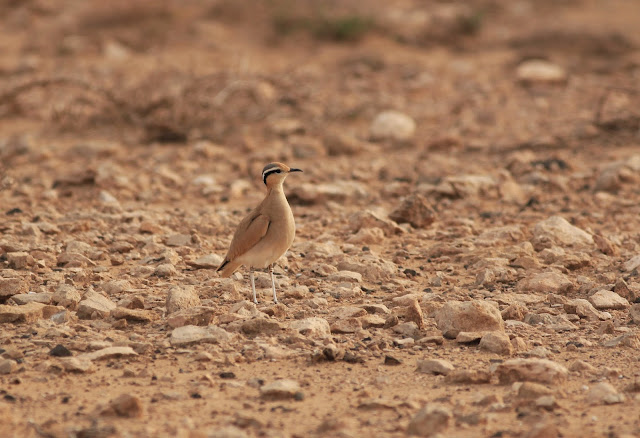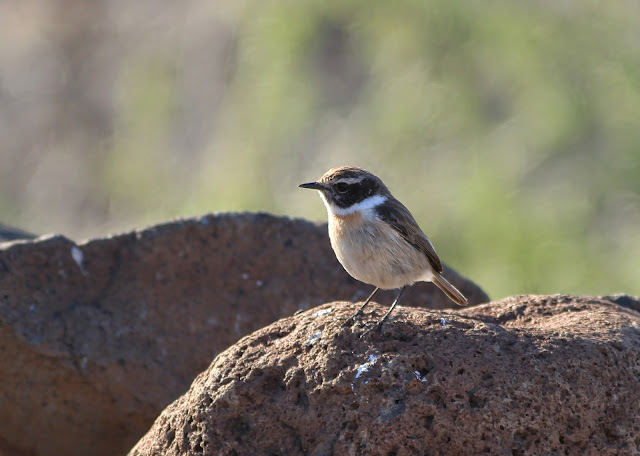Monday, December 29, 2014
Cream-coloured Coursers - Fuerteventura #9
From a hit list of about ten specialities which we wanted to get up close and personal with on the island, Cream-coloured Coursers were very much one of the main attractions before we'd arrived; as it turned out, they were even better value than we'd hoped, and were arguably the bird of the trip for me.
Combining pretty much every attribute required of a truly star bird - characterful, uniquely odd, stunningly beautiful, exquisitely coloured, and very much a reflection of the habitat they've adapted to - we found them regularly on stony plains and in semi-desert/steppe-type environments across the island; we also found them hard to leave, fascinating and hypnotising as they were.
Friday, December 26, 2014
Koenigi Southern Grey Shrikes - Fuerteventura #8
Any shrike is a great shrike, and those on Fuerteventura are not only an endemic subspecies (Koenigi) but also accommodating, full of character and often very vocal; hence, one of the birds of the trip, and encountered with pleasing regularity in a variety of habitats.
Tuesday, December 23, 2014
Berthelot's Pipits - Fuerteventura #7
Endemic to The Canaries and Madeira, Berthelot's Pipits are common and widespread on Fuerteventura in most habitats, from sandy semi-desert to lava fields and cultivations, and are often remarkably tame.
Sunday, December 21, 2014
Fuerteventura Chats - Fuerteventura #6
One of the main targets of the trip - especially since, while there are various endemic races, near-endemics and other assorted specialities, they're the only actual Fuerteventuran endemic species (so far, with more splits no doubt likely in the future) - Fuerteventura Chats were thinly scattered but widespread on the island, favouring sparsely vegetated barrancos (dry stream beds) in rocky terrain.
Smart little birds they are too, particularly the males; as well as the obvious plumage differences, they're noticeably longer and thinner billed than our Stonechats, are slightly longer-tailed, and as Amity pointed out, their dashing eye-brow lends them a certain drag queen-like sensibility (and you won't find that kind of insight in Collins).
Perhaps the easiest place to catch up with them was along the banks of Los Molinos reservoir, from the parking spot near the dam and then along towards the goat farm.
Friday, December 19, 2014
Trumpeters and (endemic) Linnets - Fuerteventura #5
Another relatively common passerine on the sandy and stony plains of the island, Trumpeter Finches were often frustratingly hard to pin down, until we found a wonderfully accommodating flock at the goat farm by Los Molinos; an entertaining little troupe that allowed very close approach, and were a pleasure to watch closely for a while.
Linnets of the endemic Eastern Canary Islands race (C.c.Harteti) were relatively well scattered in small numbers, although again were usually difficult to get close to; we found the best numbers, and the best opportunities to observe them, came at Costa Calma Park, where we'd up to 30 on our visits, (slightly bizarrely, alongside Yellow-browed Warblers and Monarchs).
Thursday, December 18, 2014
Lesser Short-toed Larks - Fuerteventura #4
A pleasingly regular occurrence throughout the island, Lesser Short-toed Larks were well represented in a variety of arid habitats, and (along with Bertholot's Pipits) were often the only passerine species in the more unforgiving environments.
Tuesday, December 16, 2014
Black-bellied Sandgrouse - Fuerteventura #3
Another species we were keen to pin down on the island, Black-bellied Sandgrouse were thankfully quite easy to come by in the right habitat (although true to form were generally pretty shy and hard to get close to).
We found them in several areas from the far north to the far south, usually on sandy plains with varying rocky and low scrub components; the highest densities were in the environs of Los Molinos reservoir (in the mid-west of the island) and its neighbouring goat farms, which provided a suitably Fuerteventuran backdrop to photo opportunities of mobile flocks.
Sunday, December 14, 2014
Yellow-browed Warblers - Fuerteventura #2
Although we were aware Yellow-browed Warblers are known to occur - in very small numbers - on the Canaries in late autumn and winter, we didn't expect to come across them quite so easily, or indeed quite so many at once. We found them in two spots without much effort - in the Barranco de Las Penitas (see last post), and closer to base, in Costa Calma.
A small tourist town a short drive from our hotel on the south coast of the island, Costa Calma has a small public park by a busy roundabout and the main road, with - unusually - relative mature trees set on ornamental grounds. We were there for just a few minutes before hearing that always welcome tsooeest, and within half an hour we'd at least four birds - feeding avidly, and somewhat bizarrely, in palm trees and tamarisks.
We visited the park several times over the week, and became accustomed to their company on each occasion. As Rich pointed out, we've been lucky enough to see them on three continents - personally, bucketloads in Asia, many on the East coast here in Blighty (including 40-odd since moving to Filey in 2012), and now a handful of legitimate wintering birds on an African island. Every one a pleasure.
Subscribe to:
Comments (Atom)




















































